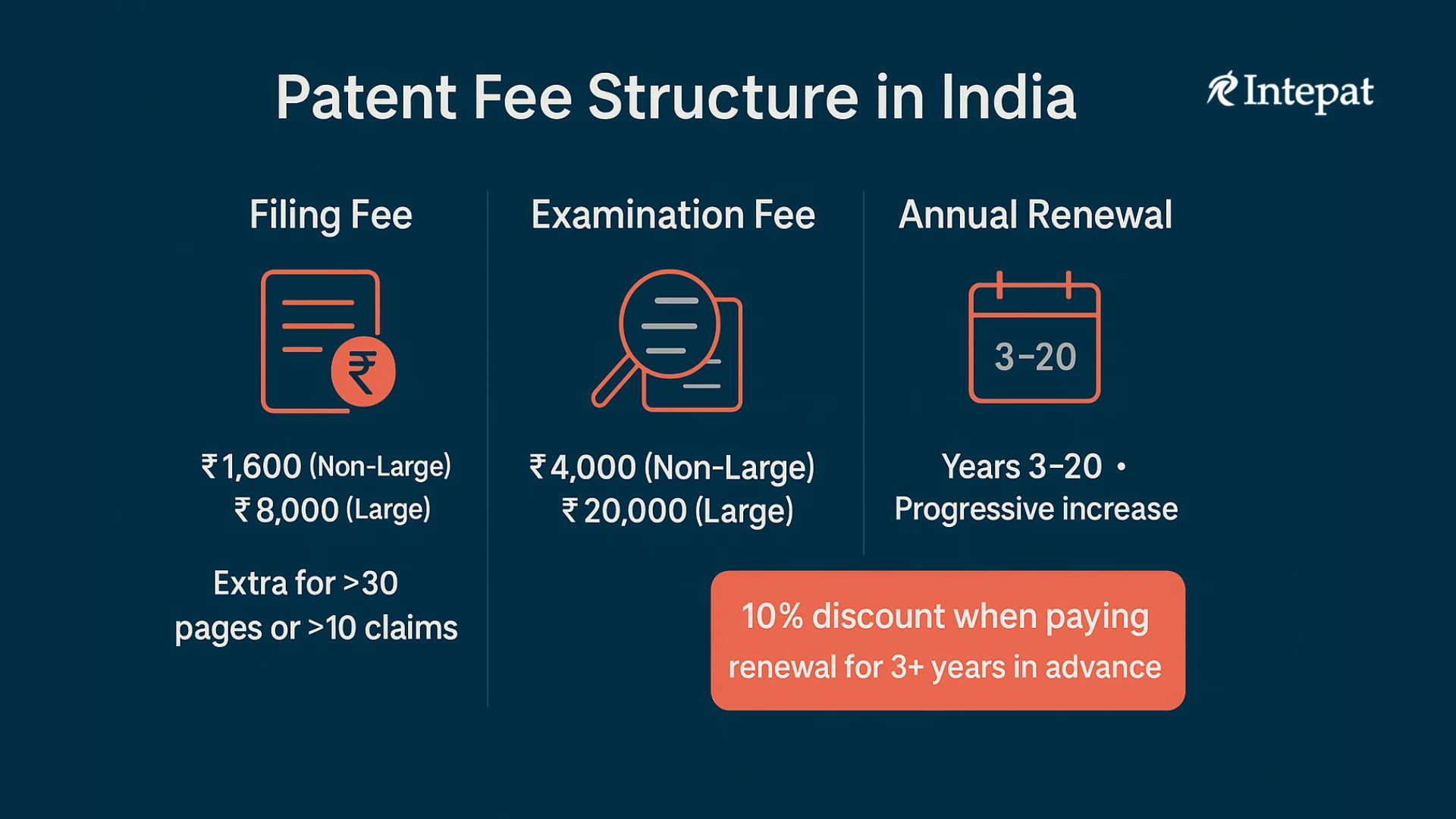
Introduction
One of the first questions inventors, startups, MSMEs, and businesses ask before filing a patent is:
“How much will a patent cost in India?”
Patent fees in India including patent filing fees, examination fees, and patent renewal fees are governed by theIndian Patent Office (IPO)
and are payable at different stages of the process. Thesepatent costs in India
vary based on the applicant category, with individuals, startups, and MSMEs receiving significant fee reductions, while large entities pay as per the standard IPO fee schedule.To simplify the process,
Intepat
offers two interactive tools: thePatent Fees Calculator
, which helps youestimate patent filing fees and examination charges, and the Patent Renewal Calculator
, which calculates annual renewal fees from the 3rd to the 20th year. This page also includes detailed tables, renewal schedules, and explanations — making it one of the most comprehensive guides to understandingpatent fees, patent filing charges, and patent renewal fees in India and Bangalore
, as well as other major cities like Chennai.Patent Filing Fees and Examination Costs in India
Fees
Total Fee:₹ 0
When a
patent application is filed in India
, the applicant must pay abasic patent filing fee
prescribed by theIndian Patent Office (IPO)
. This base fee covers a patent specification of up to thirty pages and up to ten claims. If the specification exceeds these limits,additional charges apply per extra page or claim
.Beyond filing, every applicant is required to
file a Request for Examination (RFE)
within forty-eight months of the earliest priority date. This process incurs a separatepatent examination fee
, which varies depending on whether the applicant is anindividual, startup, MSME, or large entity
. Without this examination request, the patent application will not proceed to substantive examination.The
Intepat Patent Fee Calculator
provides an instant estimate ofpatent filing and examination fees in India
, including theofficial IPO government charges
for your specificentity type and document size
. Whether you are based inBangalore, Chennai, or elsewhere in India
, this calculator helps you understand yourexpected patent filing cost
quickly and accurately.Filing and Examination Fee Schedule
For transparency, here is a summary of the official IPO fees:
| Particulars | Individuals / Startups / MSMEs | Large Entities |
|---|---|---|
| Filing (up to 30 pages & 10 claims) | ₹1,600 | ₹8,000 |
| Extra page (beyond 30) | ₹160 | ₹800 |
| Extra claim (beyond 10) | ₹320 | ₹1,600 |
| Examination request | ₹4,000 | ₹20,000 |
| Expedited examination (optional) | ₹8,000 | ₹60,000 |
These charges are directly drawn from the official IPO fee schedule. Our calculator ensures you don’t need to crunch these numbers manually.
Patent Renewal Fees and Annual Maintenance in India
Once a
patent is granted in India
, it must be renewed every year starting from thethird year until the twentieth year
of its term. Thepatent renewal fees
— also known asannual maintenance fees
— gradually increase as the patent ages. This structure, set by theIndian Patent Office (IPO)
, ensures that only patents with ongoingcommercial value
are maintained, while less valuable ones may be allowed to lapse.The
Intepat Patent Renewal Calculator
gives you an instant breakdown ofofficial patent renewal fees in India
, including theannual maintenance cost
for each year fromYear 3 to Year 20
. It helps you estimate yourtotal renewal cost
in advance and plan yourIP budget
efficiently — whether you’re anindividual, startup, MSME, or company
based inBangalore, Chennai, or anywhere in India
.Renewal Fee Schedule (Years 3–20)
| Year | Non-Large Entities | Large Entities |
|---|---|---|
| 3–5 | ₹800 each year | ₹4,000 each year |
| 6–9 | ₹2,000 each year | ₹6,000 each year |
| 10–14 | ₹4,000 each year | ₹12,000 each year |
| 15–20 | ₹8,000 each year | ₹24,000 each year |
Another useful feature of the Indian patent system is that renewal fees may be paid in advance. If you pay for more than three years at once, you receive a 10% discount. This is particularly advantageous for companies with large patent portfolios because it reduces both cost and administrative work.
The Patent Lifecycle and Associated Costs in India
Looking at
patent fees in India
as isolated numbers can be confusing. It’s easier to understand them as part of a completetwenty-year patent lifecycle
. In the early stages, the key expenses are thepatent filing fees
and any additional page or claim charges. This is followed by thepatent examination fee
, which must be paid to move the application into active review by theIndian Patent Office (IPO)
.Once a
patent is granted
, attention shifts toannual renewal or maintenance fees
, which start low but gradually increase in later years. This progressive fee structure encourages inventors and companies to maintain only patents that continue to holdcommercial value
. By understanding this fullpatent cost lifecycle
,inventors, startups, and businesses in Bangalore, Chennai, and across India
can plan IP budgets effectively and make informed decisions about which patents to renew or allow to lapse.Why Choose Intepat’s Patent Fee Calculators?
What sets
Intepat’s Patent Fees and Renewal Calculators
apart is theircompleteness and accuracy
. Instead of referring to separate tables forpatent filing, examination, and renewal fees
, Intepat providestwo dedicated calculators
— each aligned with thelatest Indian Patent Office fee schedule (2025)
.The tools cover the
entire patent lifecycle
, frominitial filing to the twentieth year of maintenance
, giving a complete picture of yourpatent costs in India
. Whether you are calculatingpatent renewal fees in Bangalore
orpatent filing fees in Chennai
, Intepat’s calculators provide precise, up-to-date information.For inventors and businesses seeking more than just numbers,
Intepat’s expert Patent Services
ensure your patents arestrategically filed, renewed, and maintained
with full compliance and cost efficiency.Frequently Asked Questions
Do Individuals, Startups, and MSMEs all pay the same fees?
Yes. The IPO groups these applicants together under the “non-large entity” category. They all pay the reduced fee schedule, which is significantly lower than the charges for large entities.
Are attorney or professional fees included in the calculators?
No. The calculators are designed to reflect only the official government fees. Professional fees for drafting, filing, and prosecution are separate and vary depending on the complexity of the invention. For a complete cost estimate including professional support, you may contact us.
When do renewal fees start?
Renewal fees become payable from the third year onwards. The first two years after filing do not require renewal payments.
Can renewal fees be paid in advance?
Yes, and doing so comes with a benefit. If renewal fees are paid for more than three years in one installment, the IPO grants a 10% discount. Many applicants prefer this option as it lowers cost and reduces the risk of unintentional lapse.
What happens if renewal fees are not paid?
If the renewal fee is not paid on time, the patent will lapse. A grace period of six months is available with late fees. Restoration may be possible within eighteen months from the lapse date, but it requires a formal request, additional fees, and justification, and the Patent Office has discretion to accept or reject the restoration.
Why do renewal fees increase over time?
The progressive increase is a policy decision. It ensures that only patents with genuine commercial or strategic value are maintained into later years, while less relevant ones naturally expire. This balances the patent system by keeping the register free of unused monopolies.
Conclusion: Plan and Manage Your Patent Fees Effectively
Patent protection in India
is a twenty-year journey, and understanding thepatent fee structure
is essential for budgeting, renewal tracking, and long-term IP strategy. WithIntepat’s Patent Fee Calculator
andPatent Renewal Calculator
, supported byofficial IPO fee tables
and detailed lifecycle insights, you can calculate yourpatent filing, examination, and renewal costs
with confidence.Whether you are an
